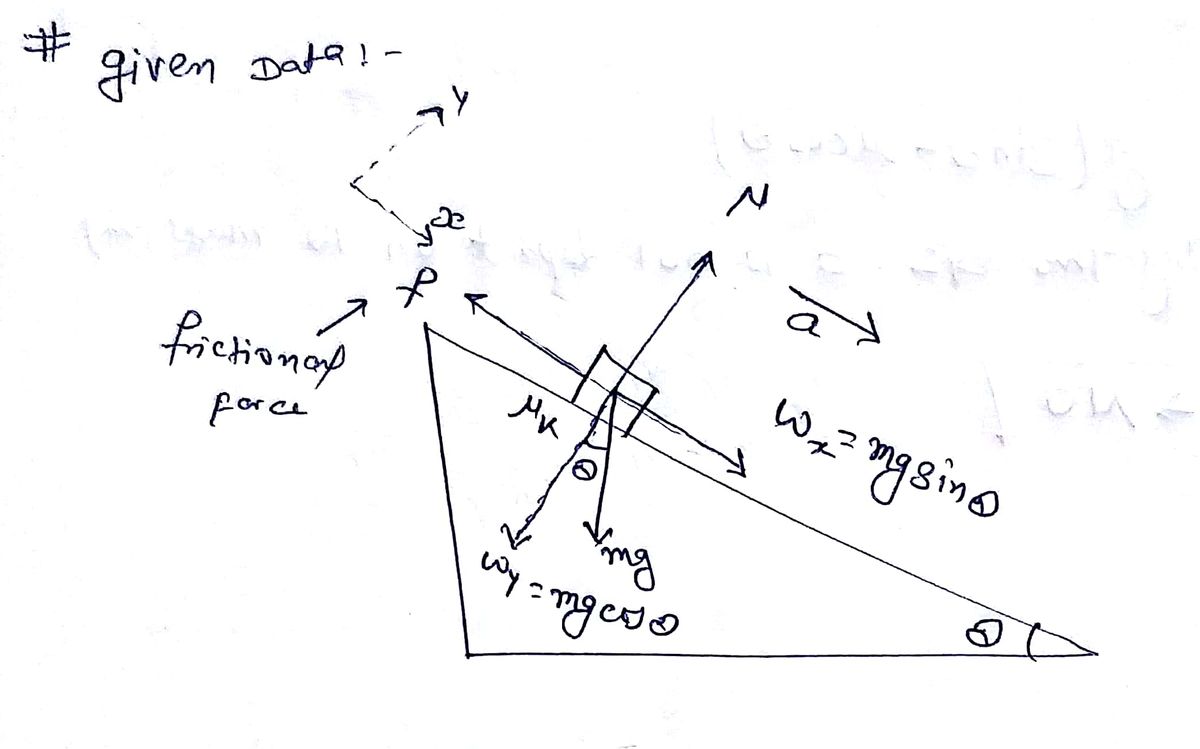Please answer the following question(s): 1. An object of mass m is sliding down an incline that makes an angle 0 with the horizontal with an acceleration a. The coefficient of kinetic friction between the block and the incline is Fnet,x (a) Newton's Second Law along the x- and y-axes are written below. Fill in the net force along x- and y- axes in terms of the normal force N, components of the weight w and Wyr and the force of friction f. Use the correct signs for the forces in relation to the coordinate axes as shown in Part 1. ==WX Fnet.y = 2 f: 1584 = = N : 243.43 38 43 mgcose (b) Using equation (2) express N and f in terms of m, g, 0, and u N ✓- f ✔-wy =ma (1) ✓= 0 (2)
Please answer the following question(s): 1. An object of mass m is sliding down an incline that makes an angle 0 with the horizontal with an acceleration a. The coefficient of kinetic friction between the block and the incline is Fnet,x (a) Newton's Second Law along the x- and y-axes are written below. Fill in the net force along x- and y- axes in terms of the normal force N, components of the weight w and Wyr and the force of friction f. Use the correct signs for the forces in relation to the coordinate axes as shown in Part 1. ==WX Fnet.y = 2 f: 1584 = = N : 243.43 38 43 mgcose (b) Using equation (2) express N and f in terms of m, g, 0, and u N ✓- f ✔-wy =ma (1) ✓= 0 (2)
College Physics
11th Edition
ISBN:9781305952300
Author:Raymond A. Serway, Chris Vuille
Publisher:Raymond A. Serway, Chris Vuille
Chapter1: Units, Trigonometry. And Vectors
Section: Chapter Questions
Problem 1CQ: Estimate the order of magnitude of the length, in meters, of each of the following; (a) a mouse, (b)...
Related questions
Question

Transcribed Image Text:X
ctivity Branding&COURSEID=3377&SECTIONID=170728
%
fs
+
Please answer the following question(s):
O
1. An object of mass m is sliding down an incline that makes an angle 0 with the horizontal with an
acceleration a. The coefficient of kinetic friction between the block and the incline is k
Fnet,x
(a) Newton's Second Law along the x- and y-axes are written below. Fill in the net force along x- and y-
axes in terms of the normal force N, components of the weight w, and wy, and the force of friction f.
Use the correct signs for the forces in relation to the coordinate axes as shown in Part 1.
= = WX
Fnet.y
= = N
21
Omgcose
(b) Using equation (2) express N and f in terms of m, g, 0, and u
N
<
17 4-
&
7
hip
18
4+
f: 158.4
*
O
243.43
fg
wy
f10
▶II
f11
A
=ma (1)
✓= 0 (2)
Rain...
f12
+
=
insert
pr
← ba

Transcribed Image Text:tivity Branding&COURSEID=3377&SECTIONID=170728
Omgsine
%
(c) In equation (1), substitute for wx, Wy
acceleration a.
To type your equations, you can enter Greek letters and subscripts by selecting the MathType
popup button (red radical) in the answer box. To enter subscripts, press the first right-facing
arrow in menu of the popup. For Greek letters, press the right-facing arrow next to the alpha (
a) symbol.
Note: To enter terms such as "mg", use m*g.
Factorize as much as possible.
O
5
a=
(d) Does a depend on m?
no
Ei
Discussion: Consider this problem with the x-axis parallel to the ground and y-axis perpendicular to
it; the normal force N and force of friction f have both horizontal and vertical components. The same
is true with the acceleration. What happens if the coordinate system is rotated?
^
6
&
7
hp
18
*
N and f in terms of m, g, 0, and u and solve for the
4+
8
Answering the question(s) helps us recommend your next activity.
f10 11
fr
to
A
Rain...
112
+
{
+
insert
}
4) O
2:45
9/27/2
prt s
← back
Expert Solution
Step 1

Step by step
Solved in 3 steps with 3 images

Knowledge Booster
Learn more about
Need a deep-dive on the concept behind this application? Look no further. Learn more about this topic, physics and related others by exploring similar questions and additional content below.Recommended textbooks for you

College Physics
Physics
ISBN:
9781305952300
Author:
Raymond A. Serway, Chris Vuille
Publisher:
Cengage Learning

University Physics (14th Edition)
Physics
ISBN:
9780133969290
Author:
Hugh D. Young, Roger A. Freedman
Publisher:
PEARSON

Introduction To Quantum Mechanics
Physics
ISBN:
9781107189638
Author:
Griffiths, David J., Schroeter, Darrell F.
Publisher:
Cambridge University Press

College Physics
Physics
ISBN:
9781305952300
Author:
Raymond A. Serway, Chris Vuille
Publisher:
Cengage Learning

University Physics (14th Edition)
Physics
ISBN:
9780133969290
Author:
Hugh D. Young, Roger A. Freedman
Publisher:
PEARSON

Introduction To Quantum Mechanics
Physics
ISBN:
9781107189638
Author:
Griffiths, David J., Schroeter, Darrell F.
Publisher:
Cambridge University Press

Physics for Scientists and Engineers
Physics
ISBN:
9781337553278
Author:
Raymond A. Serway, John W. Jewett
Publisher:
Cengage Learning

Lecture- Tutorials for Introductory Astronomy
Physics
ISBN:
9780321820464
Author:
Edward E. Prather, Tim P. Slater, Jeff P. Adams, Gina Brissenden
Publisher:
Addison-Wesley

College Physics: A Strategic Approach (4th Editio…
Physics
ISBN:
9780134609034
Author:
Randall D. Knight (Professor Emeritus), Brian Jones, Stuart Field
Publisher:
PEARSON